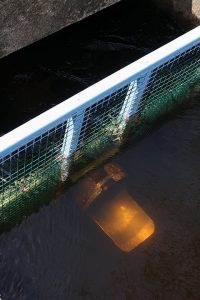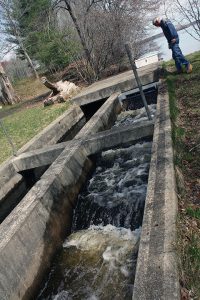The annual cycle of the herring’s return to Snipatuit Pond has reached its apex at this point in the season, but the herring continue to trickle up and then back down the multiple steps just at the beginning of the Mattapoisett River at Snipatuit Pond.
Every morning, Herring Inspector David Watling Jr. parks his pick-up truck down at the end of a long dirt road to an undisclosed location at the base of Snipatuit Pond. From there, he hikes through the towering pines to where water fed from the banks of Snipatuit Pond flows down the concrete steps towards the ocean. These steps mark the final hurdle in the herring’s return home to spawn in the very place where the herring itself was born.
Watling keeps careful track of the herring count, both as herring inspector and as Vice President of Alewives Anonymous, an association founded in 1984 that “encourages, promotes, and supports efforts to preserve and increase the alewife fishery resources of the Mattapoisett River…”
Watling’s father, William Watling, founded Alewives Anonymous, and Watling has followed in his father’s footsteps as herring inspector since 1993.
“When my father died, I took over his position,” said Watling.
On Monday, April 24, the sun unencumbered by clouds created the aroma of warming pine needles and the refreshing scent of the water of Snipatuit Pond evaporating into the fresh air around us.
The Snipatuit Pond herring count is one of two locations inspected by Watling daily, beginning April 16 until just before Memorial Day when the wooden planks at the herring steps are removed, flooding the river in time for the boat race. The other location is at Leonard’s Pond. Watling then takes a trip over to the Mattapoisett River landing in Mattapoisett off Route 6 to visually inspect the herring highway, so to speak.
As of Monday, 12,754 herring have passed through the Snipatuit Pond counter, which doesn’t count herring, per se; what the counter senses is a change in the conductivity of the water as the herring swim upstream and then eventually back downstream.
“Right now are the perfect conditions for the fish,” Watling remarked, his clipboard in hand looking over the spreadsheet of data that he keeps for the town and for the Alewives Anonymous group, and which he also shares with the Buzzards Bay Coalition. The water level was high and the water temperature right for the time of year.
That past Saturday through Sunday, said Watling, between 2,000 and 3,000 herring had swum up into the pond, according to his data.
That may sound like a lot, but these numbers are, in fact, drastically low. Last year by the end of the season, Watling had counted around 18,000 alewives, evidence of the 25% decline in fish annually since 2000 when the count was 134,000.
“So we’re a little bit behind this year,” said Watling.
Once the data is entered and the white metal box closed and secured, Watling gets down on his knees, crouching over the water to pull out leaves and debris from the thatched metal – the same kind used for lobster traps – to keep the steps open and flowing for the herring. If a herring becomes trapped, it will continue its struggle forward until the waterway is opened up again.
“They’ll beat themselves up trying to get up,” said Watling.
As the crow flies, the mouth of the Mattapoisett River estuary is only about six miles, but Watling estimates the river winds for about 14 miles, ocean to pond.
The herring have been making this journey likely for thousands of years, and where the herring do swim, you’ll find Watling there waiting and watching for the yearly return of the ancient alewife.
By Jean Perry


